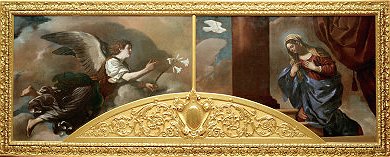The painting, (or paintings - it is not exactly clear) was removed from the molding engaging it to the church wall before the church was demolished during the 18th c. Guercino's picture was then purchased by Sir Richard Worsley and subsequently entered the collection of the Earl of Yarborough. John Ringling acquired the painting at an auction held at Christie's in London on July 12, 1929. When the painting entered the Ringling collection, there were two irregularly shaped canvases framed together in an elaborate, ornate frame, with a lunette (the semicircle at the base) filling the void where there had originally been an architectural arch. At some point after the painting had entered the Museum's collection, that frame and the canvasses were damaged. The frame was lost and the canvases were relined - that is, the irregularly shaped paintings were attached to rectangular pieces of canvas. E. Orly Korany was the restorer who repaired the painting in 1962. At this same time, simple wooden-strip frames were constructed to protect the edges of the canvases. The Museum was fortunate to have had a photograph documenting the painting as it was when John Ringling purchased it. Since no model of the original frame existed it was not possible to recreate that exact frame; however, every effort was made to create a 17th century-style Bolognese frame similar to the original frame as seen in the earlier photograph. The new frame was a collaborative professional effort by the Director, the Curator of Italian Art and Conservators. The carving was executed by A.P.F. Inc., Master Framemakers in New York. The frame is in an Italian baroque style. The outer edge was made from an exact mold of an authentic 17th c. Bolognese frame (on the Museum's painting by Sisto Badalocchio). The decoration of the inner lunette was based on an Italian 17th c. ornament reproduced in a volume on baroque decorative motifs. The new frame was intended to enhance the presentation of the work in the gallery. It
gives the painting a renewed sense of baroque monumentality, and more important, visual
coherency for the viewer. It is now easier to understand that the work was painted to go
over an arch.
|
